check engine Hyundai Santa Fe 2009 Owner's Manual - RHD (UK, Australia)
[x] Cancel search | Manufacturer: HYUNDAI, Model Year: 2009, Model line: Santa Fe, Model: Hyundai Santa Fe 2009Pages: 269, PDF Size: 9.78 MB
Page 60 of 269
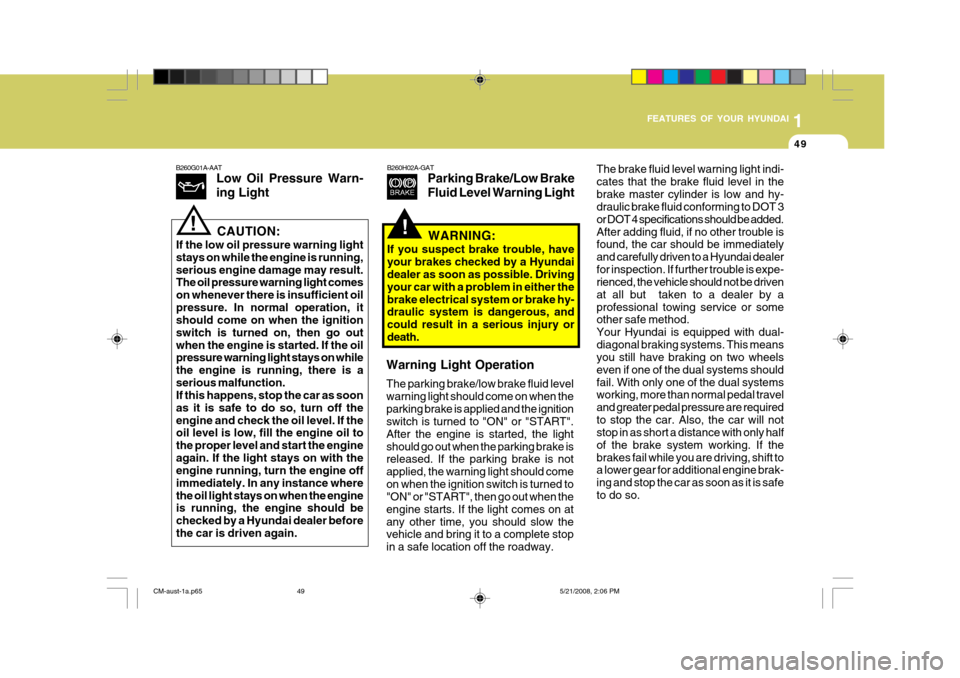
1
FEATURES OF YOUR HYUNDAI
49
!
B260G01A-AAT
Low Oil Pressure Warn- ing Light
CAUTION:
If the low oil pressure warning light stays on while the engine is running,serious engine damage may result. The oil pressure warning light comes on whenever there is insufficient oilpressure. In normal operation, it should come on when the ignition switch is turned on, then go outwhen the engine is started. If the oil pressure warning light stays on while the engine is running, there is aserious malfunction. If this happens, stop the car as soon as it is safe to do so, turn off theengine and check the oil level. If the oil level is low, fill the engine oil to the proper level and start the engineagain. If the light stays on with the engine running, turn the engine off immediately. In any instance wherethe oil light stays on when the engine is running, the engine should be checked by a Hyundai dealer beforethe car is driven again.
!
B260H02A-GAT Parking Brake/Low Brake Fluid Level Warning Light
WARNING:
If you suspect brake trouble, have your brakes checked by a Hyundai dealer as soon as possible. Driving your car with a problem in either thebrake electrical system or brake hy- draulic system is dangerous, and could result in a serious injury or death.
Warning Light Operation The parking brake/low brake fluid level warning light should come on when theparking brake is applied and the ignition switch is turned to "ON" or "START". After the engine is started, the lightshould go out when the parking brake is released. If the parking brake is not applied, the warning light should comeon when the ignition switch is turned to "ON" or "START", then go out when the engine starts. If the light comes on atany other time, you should slow the vehicle and bring it to a complete stop in a safe location off the roadway. The brake fluid level warning light indi-cates that the brake fluid level in thebrake master cylinder is low and hy- draulic brake fluid conforming to DOT 3 or DOT 4 specifications should be added.After adding fluid, if no other trouble is found, the car should be immediately and carefully driven to a Hyundai dealerfor inspection. If further trouble is expe- rienced, the vehicle should not be driven at all but taken to a dealer by aprofessional towing service or some other safe method. Your Hyundai is equipped with dual-diagonal braking systems. This means you still have braking on two wheels even if one of the dual systems shouldfail. With only one of the dual systems working, more than normal pedal travel and greater pedal pressure are requiredto stop the car. Also, the car will not stop in as short a distance with only half of the brake system working. If thebrakes fail while you are driving, shift to a lower gear for additional engine brak- ing and stop the car as soon as it is safeto do so.
CM-aust-1a.p65
5/21/2008, 2:06 PM
49
Page 61 of 269
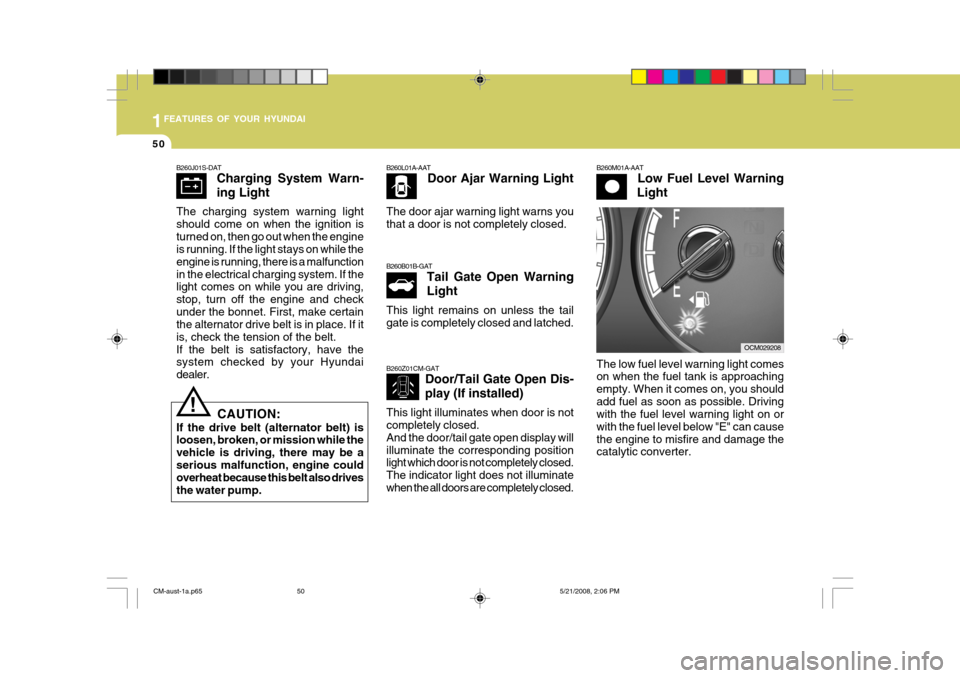
1FEATURES OF YOUR HYUNDAI
50
B260J01S-DAT
Charging System Warn- ing Light
The charging system warning light should come on when the ignition isturned on, then go out when the engine is running. If the light stays on while the engine is running, there is a malfunctionin the electrical charging system. If the light comes on while you are driving, stop, turn off the engine and checkunder the bonnet. First, make certain the alternator drive belt is in place. If it is, check the tension of the belt.If the belt is satisfactory, have the system checked by your Hyundai dealer. B260L01A-AAT
Door Ajar Warning Light
The door ajar warning light warns youthat a door is not completely closed. B260M01A-AAT
Low Fuel Level Warning
Light
B260B01B-GAT Tail Gate Open Warning Light
This light remains on unless the tail gate is completely closed and latched.
! CAUTION:
If the drive belt (alternator belt) is loosen, broken, or mission while the vehicle is driving, there may be aserious malfunction, engine could overheat because this belt also drives the water pump. B260Z01CM-GAT
Door/Tail Gate Open Dis- play (If installed)
This light illuminates when door is not completely closed. And the door/tail gate open display willilluminate the corresponding position light which door is not completely closed. The indicator light does not illuminatewhen the all doors are completely closed.
The low fuel level warning light comes on when the fuel tank is approaching empty. When it comes on, you shouldadd fuel as soon as possible. Driving with the fuel level warning light on or with the fuel level below "E" can causethe engine to misfire and damage the catalytic converter.
OCM029208
CM-aust-1a.p65 5/21/2008, 2:06 PM
50
Page 62 of 269
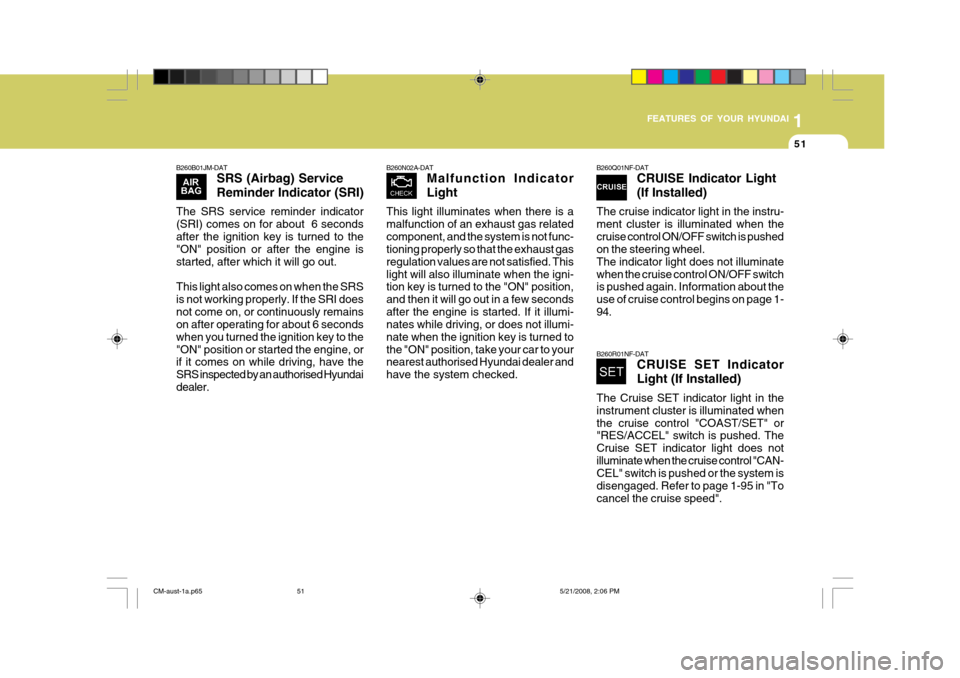
1
FEATURES OF YOUR HYUNDAI
51
B260B01JM-DAT SRS (Airbag) Service Reminder Indicator (SRI)
The SRS service reminder indicator (SRI) comes on for about 6 secondsafter the ignition key is turned to the "ON" position or after the engine is started, after which it will go out. This light also comes on when the SRS is not working properly. If the SRI doesnot come on, or continuously remains on after operating for about 6 seconds when you turned the ignition key to the"ON" position or started the engine, or if it comes on while driving, have the SRS inspected by an authorised Hyundaidealer.
B260N02A-DAT Malfunction Indicator Light
This light illuminates when there is a malfunction of an exhaust gas relatedcomponent, and the system is not func- tioning properly so that the exhaust gas regulation values are not satisfied. Thislight will also illuminate when the igni- tion key is turned to the "ON" position, and then it will go out in a few secondsafter the engine is started. If it illumi- nates while driving, or does not illumi- nate when the ignition key is turned tothe "ON" position, take your car to your nearest authorised Hyundai dealer and have the system checked. B260Q01NF-DAT
CRUISE Indicator Light (If Installed)
The cruise indicator light in the instru- ment cluster is illuminated when thecruise control ON/OFF switch is pushed on the steering wheel. The indicator light does not illuminatewhen the cruise control ON/OFF switch is pushed again. Information about the use of cruise control begins on page 1-94.
B260R01NF-DAT CRUISE SET Indicator Light (If Installed)
The Cruise SET indicator light in the instrument cluster is illuminated whenthe cruise control "COAST/SET" or "RES/ACCEL" switch is pushed. The Cruise SET indicator light does notilluminate when the cruise control "CAN- CEL" switch is pushed or the system is disengaged. Refer to page 1-95 in "Tocancel the cruise speed".
CM-aust-1a.p65 5/21/2008, 2:06 PM
51
Page 63 of 269
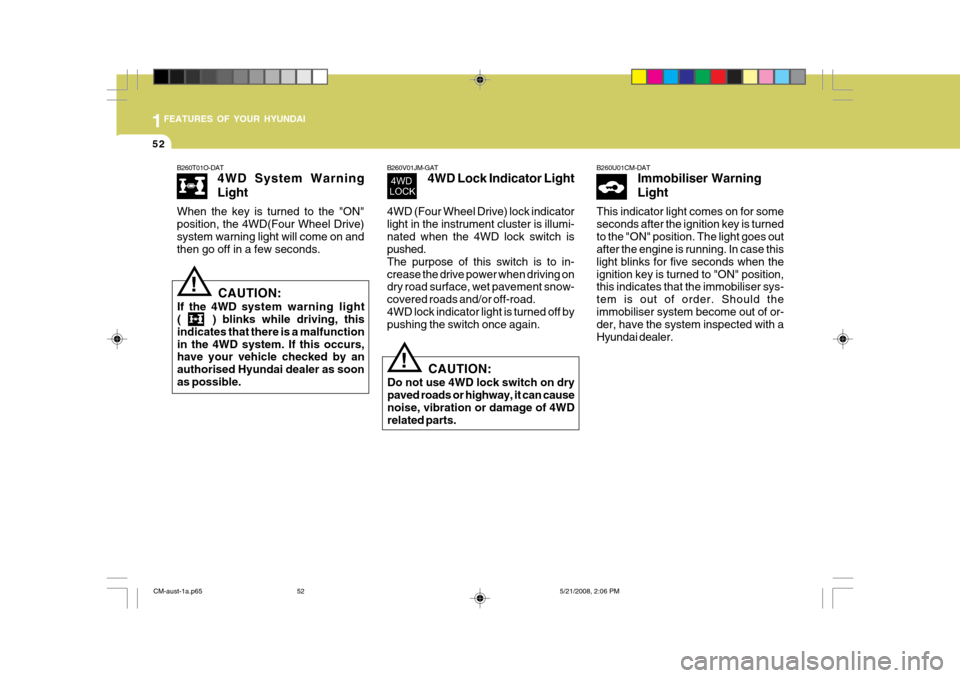
1FEATURES OF YOUR HYUNDAI
52
B260T01O-DAT 4WD System Warning Light
When the key is turned to the "ON" position, the 4WD(Four Wheel Drive)system warning light will come on and then go off in a few seconds.
CAUTION:
If the 4WD system warning light ( ) blinks while driving, this indicates that there is a malfunction in the 4WD system. If this occurs, have your vehicle checked by an authorised Hyundai dealer as soonas possible.! B260V01JM-GAT
4WD Lock Indicator Light
4WD (Four Wheel Drive) lock indicator light in the instrument cluster is illumi-nated when the 4WD lock switch is pushed. The purpose of this switch is to in-crease the drive power when driving on dry road surface, wet pavement snow- covered roads and/or off-road.4WD lock indicator light is turned off by pushing the switch once again.
CAUTION:
Do not use 4WD lock switch on dry paved roads or highway, it can cause noise, vibration or damage of 4WD related parts.
!
B260U01CM-DAT Immobiliser Warning Light
This indicator light comes on for some seconds after the ignition key is turnedto the "ON" position. The light goes out after the engine is running. In case this light blinks for five seconds when theignition key is turned to "ON" position, this indicates that the immobiliser sys- tem is out of order. Should theimmobiliser system become out of or- der, have the system inspected with a Hyundai dealer.
CM-aust-1a.p65 5/21/2008, 2:06 PM
52
Page 66 of 269
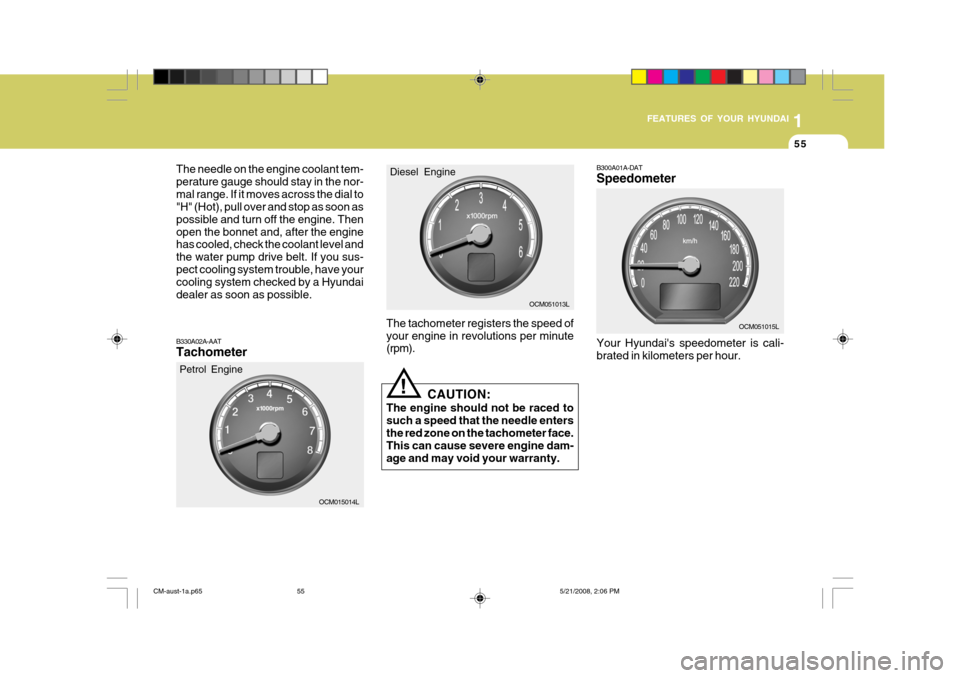
1
FEATURES OF YOUR HYUNDAI
55
The needle on the engine coolant tem- perature gauge should stay in the nor-mal range. If it moves across the dial to "H" (Hot), pull over and stop as soon as possible and turn off the engine. Thenopen the bonnet and, after the engine has cooled, check the coolant level and the water pump drive belt. If you sus-pect cooling system trouble, have your cooling system checked by a Hyundai dealer as soon as possible.
B330A02A-AAT Tachometer The tachometer registers the speed of your engine in revolutions per minute (rpm).
OCM015014L CAUTION:
The engine should not be raced to such a speed that the needle entersthe red zone on the tachometer face. This can cause severe engine dam- age and may void your warranty.
!
Petrol Engine
OCM051013L
Diesel Engine
OCM051015L
B300A01A-DAT Speedometer Your Hyundai's speedometer is cali- brated in kilometers per hour.
CM-aust-1a.p65
5/21/2008, 2:06 PM
55
Page 100 of 269
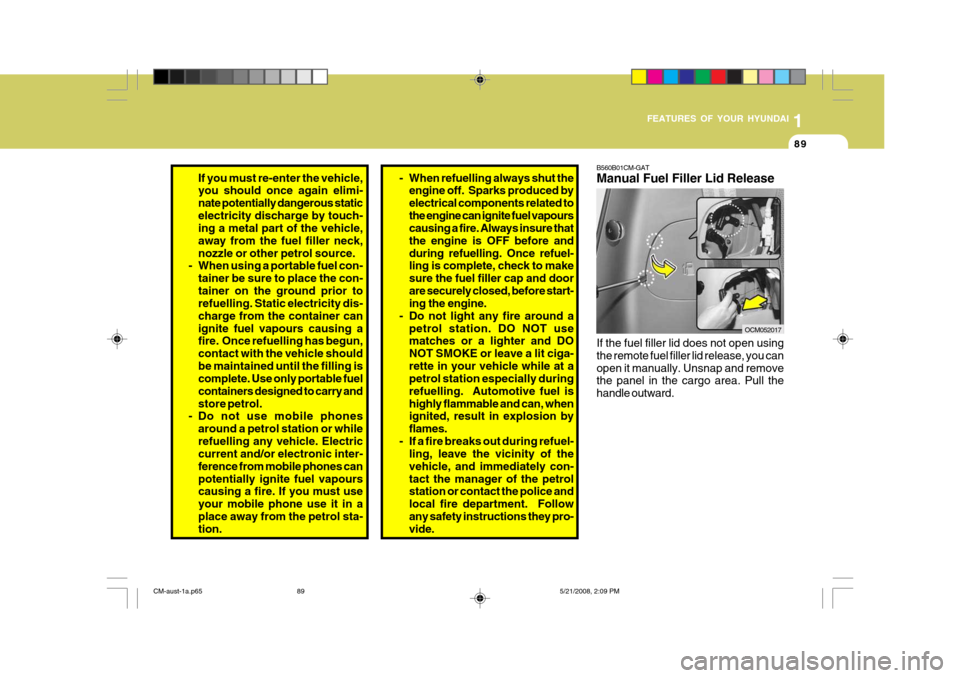
1
FEATURES OF YOUR HYUNDAI
89
B560B01CM-GAT Manual Fuel Filler Lid Release If the fuel filler lid does not open using the remote fuel filler lid release, you canopen it manually. Unsnap and remove the panel in the cargo area. Pull the handle outward.
OCM052017
If you must re-enter the vehicle, you should once again elimi- nate potentially dangerous staticelectricity discharge by touch- ing a metal part of the vehicle, away from the fuel filler neck,nozzle or other petrol source.
- When using a portable fuel con-
tainer be sure to place the con-tainer on the ground prior to refuelling. Static electricity dis- charge from the container canignite fuel vapours causing a fire. Once refuelling has begun, contact with the vehicle shouldbe maintained until the filling is complete. Use only portable fuel containers designed to carry andstore petrol.
- Do not use mobile phones
around a petrol station or whilerefuelling any vehicle. Electric current and/or electronic inter- ference from mobile phones canpotentially ignite fuel vapours causing a fire. If you must use your mobile phone use it in aplace away from the petrol sta- tion.- When refuelling always shut theengine off. Sparks produced by electrical components related tothe engine can ignite fuel vapours causing a fire. Always insure that the engine is OFF before andduring refuelling. Once refuel- ling is complete, check to make sure the fuel filler cap and doorare securely closed, before start- ing the engine.
- Do not light any fire around a petrol station. DO NOT usematches or a lighter and DO NOT SMOKE or leave a lit ciga-rette in your vehicle while at a petrol station especially during refuelling. Automotive fuel ishighly flammable and can, when ignited, result in explosion by flames.
- If a fire breaks out during refuel- ling, leave the vicinity of thevehicle, and immediately con-tact the manager of the petrol station or contact the police and local fire department. Followany safety instructions they pro- vide.
CM-aust-1a.p65 5/21/2008, 2:09 PM
89
Page 147 of 269
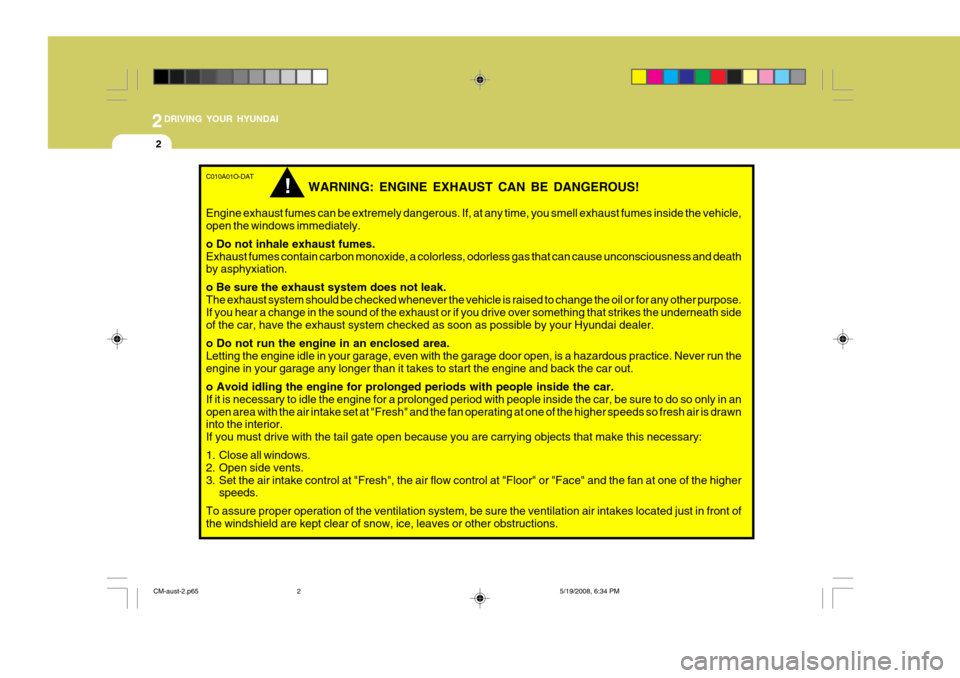
2DRIVING YOUR HYUNDAI
2
C010A01O-DAT
WARNING: ENGINE EXHAUST CAN BE DANGEROUS!
Engine exhaust fumes can be extremely dangerous. If, at any time, you smell exhaust fumes inside the vehicle, open the windows immediately. o Do not inhale exhaust fumes. Exhaust fumes contain carbon monoxide, a colorless, odorless gas that can cause unconsciousness and death by asphyxiation. o Be sure the exhaust system does not leak. The exhaust system should be checked whenever the vehicle is raised to change the oil or for any other purpose.If you hear a change in the sound of the exhaust or if you drive over something that strikes the underneath sideof the car, have the exhaust system checked as soon as possible by your Hyundai dealer. o Do not run the engine in an enclosed area. Letting the engine idle in your garage, even with the garage door open, is a hazardous practice. Never run theengine in your garage any longer than it takes to start the engine and back the car out. o Avoid idling the engine for prolonged periods with people inside the car. If it is necessary to idle the engine for a prolonged period with people inside the car, be sure to do so only in anopen area with the air intake set at "Fresh" and the fan operating at one of the higher speeds so fresh air is drawn into the interior. If you must drive with the tail gate open because you are carrying objects that make this necessary:
1. Close all windows.
2. Open side vents.
3. Set the air intake control at "Fresh", the air flow control at "Floor" or "Face" and the fan at one of the higher speeds.
To assure proper operation of the ventilation system, be sure the ventilation air intakes located just in front of the windshield are kept clear of snow, ice, leaves or other obstructions.
!
CM-aust-2.p65 5/19/2008, 6:34 PM
2
Page 148 of 269
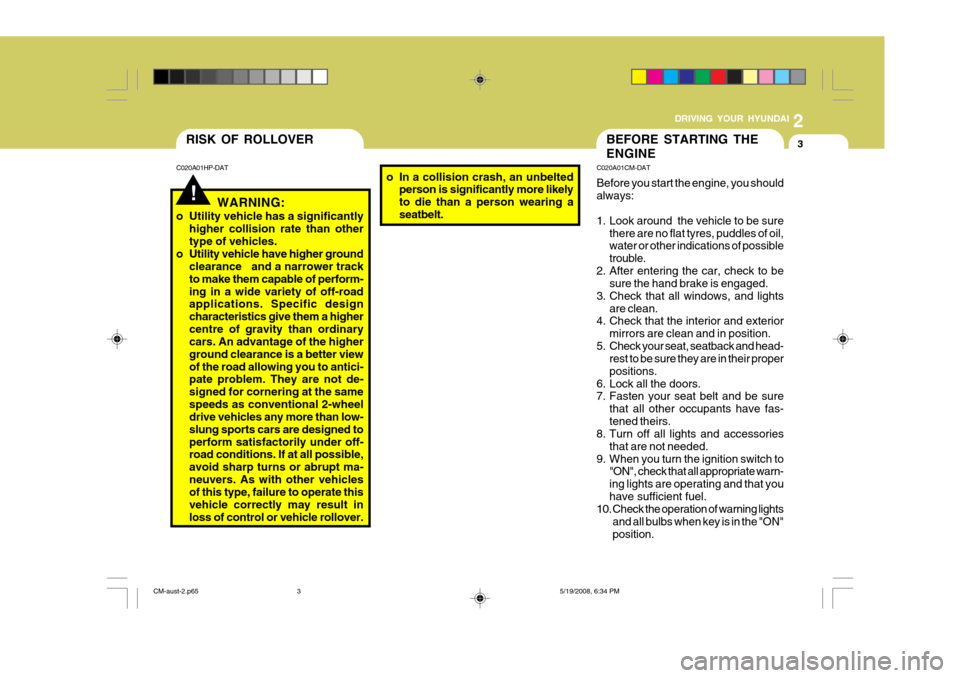
2
DRIVING YOUR HYUNDAI
3
!
BEFORE STARTING THE ENGINE
C020A01CM-DAT Before you start the engine, you should always:
1. Look around the vehicle to be sure
there are no flat tyres, puddles of oil, water or other indications of possible trouble.
2. After entering the car, check to be sure the hand brake is engaged.
3. Check that all windows, and lights are clean.
4. Check that the interior and exterior
mirrors are clean and in position.
5. Check your seat, seatback and head- rest to be sure they are in their properpositions.
6. Lock all the doors.
7. Fasten your seat belt and be sure
that all other occupants have fas- tened theirs.
8. Turn off all lights and accessories
that are not needed.
9. When you turn the ignition switch to "ON", check that all appropriate warn-ing lights are operating and that youhave sufficient fuel.
10. Check the operation of warning lights
and all bulbs when key is in the "ON"position.
C020A01HP-DAT
o In a collision crash, an unbelted
person is significantly more likelyto die than a person wearing aseatbelt.
RISK OF ROLLOVER
WARNING:
o Utility vehicle has a significantly higher collision rate than othertype of vehicles.
o Utility vehicle have higher ground clearance and a narrower trackto make them capable of perform-ing in a wide variety of off-road applications. Specific design characteristics give them a highercentre of gravity than ordinary cars. An advantage of the higher ground clearance is a better viewof the road allowing you to antici- pate problem. They are not de- signed for cornering at the samespeeds as conventional 2-wheel drive vehicles any more than low- slung sports cars are designed toperform satisfactorily under off- road conditions. If at all possible, avoid sharp turns or abrupt ma-neuvers. As with other vehicles of this type, failure to operate this vehicle correctly may result inloss of control or vehicle rollover.
CM-aust-2.p65 5/19/2008, 6:34 PM
3
Page 157 of 269
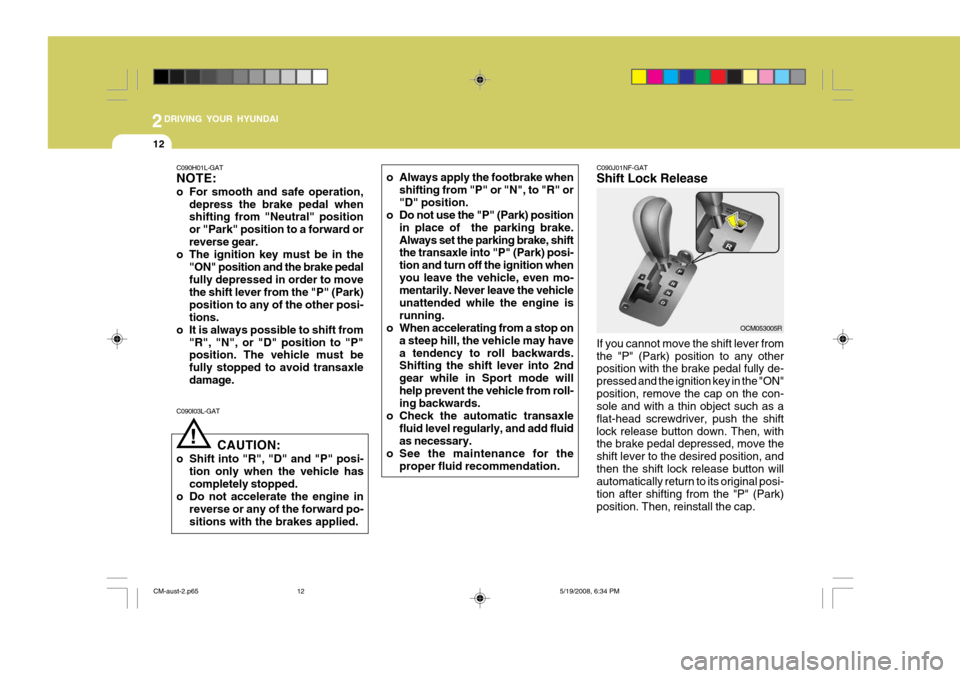
2DRIVING YOUR HYUNDAI
12
C090H01L-GAT NOTE:
o For smooth and safe operation,depress the brake pedal when shifting from "Neutral" position or "Park" position to a forward orreverse gear.
o The ignition key must be in the "ON" position and the brake pedalfully depressed in order to move the shift lever from the "P" (Park) position to any of the other posi-tions.
o It is always possible to shift from
"R", "N", or "D" position to "P" position. The vehicle must be fully stopped to avoid transaxledamage.
C090I03L-GAT
CAUTION:
o Shift into "R", "D" and "P" posi- tion only when the vehicle hascompletely stopped.
o Do not accelerate the engine in reverse or any of the forward po-sitions with the brakes applied.
! o Always apply the footbrake when
shifting from "P" or "N", to "R" or "D" position.
o Do not use the "P" (Park) position in place of the parking brake.Always set the parking brake, shift the transaxle into "P" (Park) posi- tion and turn off the ignition whenyou leave the vehicle, even mo- mentarily. Never leave the vehicle unattended while the engine isrunning.
o When accelerating from a stop on
a steep hill, the vehicle may havea tendency to roll backwards. Shifting the shift lever into 2nd gear while in Sport mode willhelp prevent the vehicle from roll- ing backwards.
o Check the automatic transaxle fluid level regularly, and add fluid as necessary.
o See the maintenance for the proper fluid recommendation.
C090J01NF-GAT Shift Lock Release If you cannot move the shift lever from the "P" (Park) position to any other position with the brake pedal fully de- pressed and the ignition key in the "ON"position, remove the cap on the con- sole and with a thin object such as a flat-head screwdriver, push the shiftlock release button down. Then, with the brake pedal depressed, move the shift lever to the desired position, andthen the shift lock release button will automatically return to its original posi- tion after shifting from the "P" (Park)position. Then, reinstall the cap. OCM053005R
CM-aust-2.p65
5/19/2008, 6:34 PM
12
Page 158 of 269
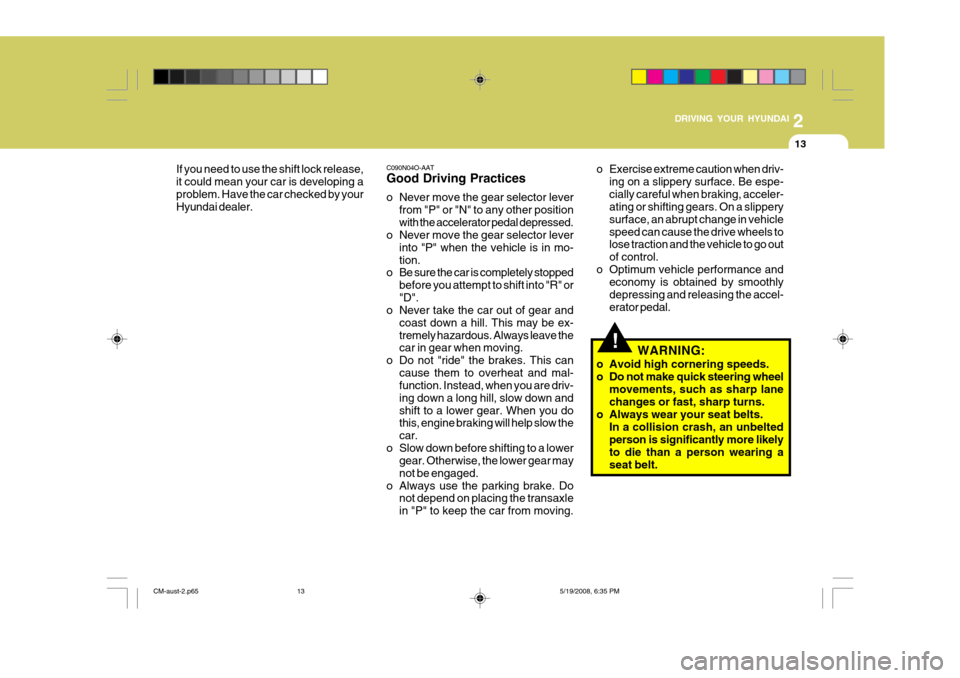
2
DRIVING YOUR HYUNDAI
13
!
C090N04O-AAT Good Driving Practices
o Never move the gear selector lever
from "P" or "N" to any other position with the accelerator pedal depressed.
o Never move the gear selector lever
into "P" when the vehicle is in mo-tion.
o Be sure the car is completely stopped
before you attempt to shift into "R" or"D".
o Never take the car out of gear and
coast down a hill. This may be ex-tremely hazardous. Always leave the car in gear when moving.
o Do not "ride" the brakes. This can cause them to overheat and mal-function. Instead, when you are driv- ing down a long hill, slow down andshift to a lower gear. When you do this, engine braking will help slow the car.
o Slow down before shifting to a lower gear. Otherwise, the lower gear maynot be engaged.
o Always use the parking brake. Do not depend on placing the transaxlein "P" to keep the car from moving.
If you need to use the shift lock release,it could mean your car is developing aproblem. Have the car checked by your Hyundai dealer.
o Exercise extreme caution when driv-
ing on a slippery surface. Be espe- cially careful when braking, acceler- ating or shifting gears. On a slippery surface, an abrupt change in vehiclespeed can cause the drive wheels to lose traction and the vehicle to go out of control.
o Optimum vehicle performance and economy is obtained by smoothlydepressing and releasing the accel-erator pedal.
WARNING:
o Avoid high cornering speeds.
o Do not make quick steering wheel movements, such as sharp lane changes or fast, sharp turns.
o Always wear your seat belts. In a collision crash, an unbelted person is significantly more likelyto die than a person wearing a seat belt.
CM-aust-2.p65 5/19/2008, 6:35 PM
13